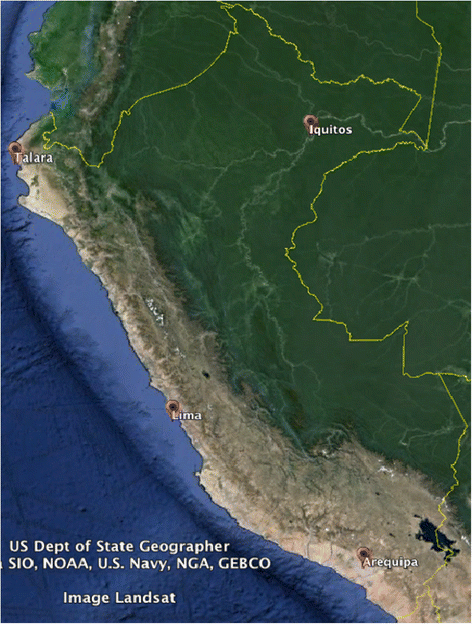Prevalence of Nasal colonization with Staphylococcus aureus in 4 cities in Peru
- PMID: 28883956
- PMCID: PMC5531008
- DOI: 10.1186/s40794-016-0025-x
Prevalence of Nasal colonization with Staphylococcus aureus in 4 cities in Peru
Abstract
Background: Antimicrobial resistance (AMR) is a growing public health threat around the world and is not well characterized in the developing setting. Specifically, there is a lack of information regarding nasal colonization with S. aureus and methicillin-resistant Staphylococcus aureus (MRSA) in Latin America and Peru.
Methods: This is the report of the baseline findings of a prospective cohort study followed up over 1 year at four geographically and ecologically distinct Peruvian Air Force bases in order to determine S. aureus nasal colonization prevalence and risk factors. Additionally, all MRSA isolates underwent molecular analysis which included pulsed-field gel electrophoresis and determination of virulence and resistance genes.
Results: We enrolled 756 military personnel. Anterior nares colonization with Staphylococcus aureus was detected in 73 of 756 participants (9.7 %) and MRSA was detected in 2 of 756 (0.3 %). Colonization rates differed significantly (P = 0.02) between geographic enrollment sites: Talara-4.3 %, Iquitos-9.1 %, Arequipa-14.0 % and Lima-11.3 %. Risk factors for S. aureus colonization included being male and a reported history of respiratory disease.
Conclusion: Overall, we found low prevalence of S. aureus and MRSA nasal colonization in this Peruvian military population. These findings contribute to the overall epidemiological understanding of S. aureus and MRSA in Latin America. The colonization rates which varied based on geographical location warrants further study.
Keywords: Antimicrobial resistance; Methicillin-resistant Staphylococcus aureus; Military personnel.
Figures
Similar articles
-
Prevalence of Staphylococcus aureus Colonization and Risk Factors for Infection Among Military Personnel in a Shipboard Setting.Mil Med. 2016 Jun;181(6):524-9. doi: 10.7205/MILMED-D-15-00274. Mil Med. 2016. PMID: 27244061
-
Prevalence of Community-Acquired Methicillin-Resistant Staphylococcus aureus Nasal Colonization Among Children.J Clin Diagn Res. 2014 Dec;8(12):DC12-5. doi: 10.7860/JCDR/2014/9986.5276. Epub 2014 Dec 5. J Clin Diagn Res. 2014. PMID: 25653946 Free PMC article.
-
Natural history of community-acquired methicillin-resistant Staphylococcus aureus colonization and infection in soldiers.Clin Infect Dis. 2004 Oct 1;39(7):971-9. doi: 10.1086/423965. Epub 2004 Sep 2. Clin Infect Dis. 2004. PMID: 15472848
-
Risk factors for and molecular characteristics of methicillin-resistant Staphylococcus aureus nasal colonization among healthy children in southern Taiwan, 2005-2010.J Microbiol Immunol Infect. 2019 Dec;52(6):929-936. doi: 10.1016/j.jmii.2018.09.003. Epub 2018 Sep 20. J Microbiol Immunol Infect. 2019. PMID: 30274893
-
Nasal colonization of methicillin resistant Staphylococcus aureus in Ethiopia: a systematic review and meta-analysis.Ann Clin Microbiol Antimicrob. 2019 Sep 5;18(1):25. doi: 10.1186/s12941-019-0324-y. Ann Clin Microbiol Antimicrob. 2019. PMID: 31488199 Free PMC article.
References
-
- Tenover FC, McAllister S, Fosheim G, McDougal LK, Carey RB, Limbago B, Lonsway D, Patel JB, Kuehnert MJ, Gorwitz R. Characterization of Staphylococcus aureus isolates from nasal cultures collected from individuals in the United States in 2001 to 2004. J Clin Microbiol. 2008;46(9):2837–41. doi: 10.1128/JCM.00480-08. - DOI - PMC - PubMed
LinkOut - more resources
Full Text Sources
Other Literature Sources


